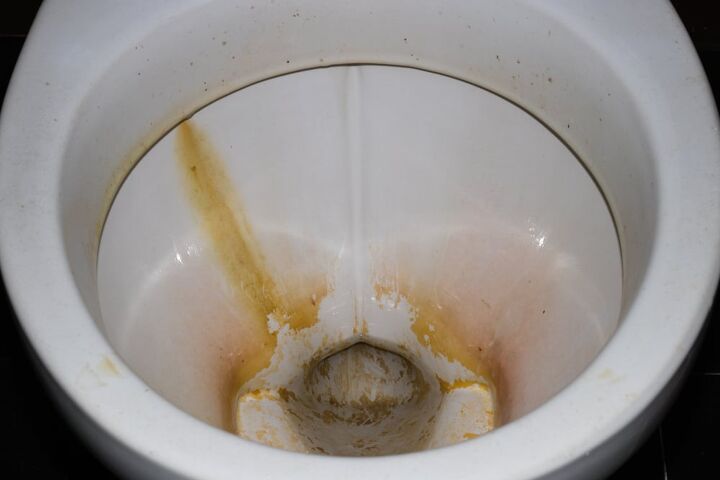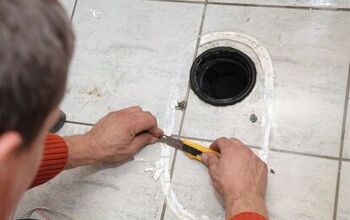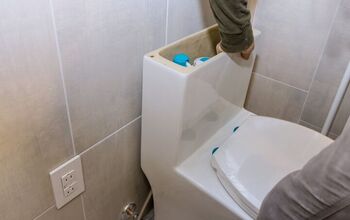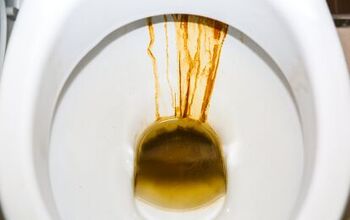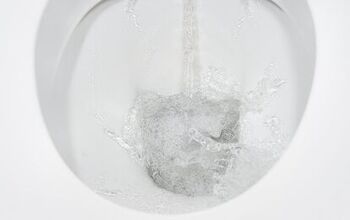What Causes Urine Scale In A Toilet? (Find Out Now!)

It’s true that your toilet is designed to handle liquid waste, but that doesn’t mean urine won’t affect it over time. It’s no secret that you should be cleaning your toilet often to keep bacteria at bay and ensure your space looks and smells good, too. Everyone urinates, but what does that really mean for your toilet over time? The main impact comes in the form of urine scale.
Urine scale is a collection of built-up urine sediments that forms in the toilet bowl due to a chemical reaction between the uric acid in pee and the limescale in the water. It’s crucial to get rid of urine scale as soon as possible by using home remedies and chemical cleaners.
Before you can know how to clean urine scale, it’s important to understand what it really is. Lucky for you, we’ll be going over all that and more right here.
Do You Need a Maid Service?
Get free, zero-commitment quotes from pro contractors near you.

What is Urine Scale?
Urine scale is made up of urine sediments that build up in your toilet over time. It develops due to a chemical reaction between urine and water with high quantities of limescale. The lime in the water bonds with the uric acid in your pee, creating the sediments that then build up inside the toilet.
The urine sediments themselves are composed mostly of microscopic particles, cells, debris from your urinary tract, and mucus. Normal sediment that has small amounts of tissue, protein, cells, and amorphous crystals. Unhealthy urine will have too much sediment, high levels of certain cells, and very specific crystals. Both healthy and unhealthy urine can cause urine scale over time.
Effects of Urine Scale
If you begin to notice mineral buildup in your toilet, you should try to clear it up right away. While urine scale is definitely an eyesore, it’s also not healthy for your bathroom either. Here are the main things you’ll be dealing with as a result of urine scale buildup.
Unsightly Sediment Stains
When urine scale forms, it forms a yellowish-brown solid stain in the bottom of your toilet bowl and around the rim of your toilet. Needless to say, it can be nauseating enough just to look at. Even if your toilet is “clean,” it will look like there’s something gross in there. For most people, this is reason enough to resolve the issue.
Smelly Drains
Bathrooms have the potential to be the most unhygienic rooms in your home, which is why you have to work harder to keep them clean. If you don’t, you’ll quickly begin to notice bad odors like sewerage and waste. Specifically with urine scale, you’ll be dealing with… You guessed it: urine smells. That won’t be pleasant for anyone.
Toilet Clogs
On top of looking and smelling bad, urine sediment buildup can cause toilet clogs over time. As it builds, it will adhere to the walls in the opening at the bottom of the toilet. Urine scale is not simply a stain; it’s actually solid. That means that as it continues to build up, it can actually close off parts of your pipes.
Bacteria Growth
The sediments that make up urine scale are a breeding ground for harmful bacteria that can contaminate your water source and spread illnesses, too. Instead of giving these bacteria a chance to grow, keep urine scale at bay as soon as it appears.
Cleaning Methods to Remove Urine Scale
It’s in your best interest to regularly clean your toilet whether it looks dirty or not. It’s especially important if you already have a bit of sediment building up. This is because the longer you leave urine scale in the toilet, the harder it will be to dissolve.
Vinegar
Vinegar is very cheap and is often a necessary household item anyway, making it an easy solution for removing urine scale and limescale deposits, too.
If the sediments have settled at the bottom of the toilet, you’ll want to turn the water off and empty as much water as possible from the toilet, so you can target the spot directly. If it’s just collecting around the toilet rim, you can probably get away with leave the water in the bowl.
First, pour a good amount of vinegar on a cloth or coat a toilet brush. Spread the solution on the urine scale inside your toilet and let it rest for a while. If you can manage leaving it overnight, do that. Once it’s time, simply flush the toilet and use a brush to get any remaining sediments off.
Baking Soda & Coca Cola
Baking soda on its own is already a very effective toilet cleaner, so it’s not surprising that it will work wonders on urine scale. To clean with baking soda, flush the toilet to remove any loos sediments and then add a few spoonsful of baking soda to the bowl and let it sit for at least an hour before flushing again and using a toilet brush on the area. The worse the urine scale, the more baking soda you should use.
You can also add Coke to the mix if the baking soda alone wasn’t enough. To do this, you’ll first pour some Coke in the drain followed by the baking soda. Leave it for one or two hours and then add more Coke and baking soda to a toilet brush and scrub the toilet. After a couple minutes, flush a few times to fully wash everything away.
Chemical Solutions
If your home remedies aren’t cutting it, you can always default to branded toilet cleaners. There are countless cleaners available that are made specifically for cleaning urine scale like Clorox® Urine Remover. Just remember to wear gloves and goggles to protect your skin.
How to Prevent Urine Scale
So far, we’ve gone over what urine scale will do to your toilet and how you can get rid of it. Now we’ll talk briefly about how to prevent urine scale from developing in the first place. That way, you’ll hopefully never have to deal with it! Here are some very easy steps you can take to keep your toilet healthy:
- Flush right away. You may be tempted to leave pee in the toilet either to conserve water or to be quiet if it’s the middle of the night. However, this will cause urine scale to arise more quickly
- Frequently Clean. This one’s self-explanatory. The best way to keep your toilet clean is to clean it!
- Clean under the rim. Cleaning the bowl is a good start, but make sure you target those hard-to-reach places like the rim and under the toilet seat where urine scale can easily grow. Toilet brushes and even old toothbrushes will be helpful for this.
- Clean your pipes and drains. Every now and then, pour a vinegar mixture or use toilet cleaning tabs to keep your drains cleared of limescale and urine scale.
Related Questions
What is limescale?
Limescale is a compound found in hard water. It is caused by calcium and magnesium buildup and contributes to the development of urine scale, too. It is not harmful to your health in small doses when it comes to your drinking water.
Is it bad to flush with the toilet seat up?
Yes, you should always close the lid before flushing. Otherwise, particles of the wastewater will fly into the air and land on anything around it. These particles are known as toilet plume.
Do You Need a Maid Service?
Get free, zero-commitment quotes from pro contractors near you.

Final Thoughts
In conclusion, urine scale is really gross. Moreover, it’s unhealthy and can emit a bad smell, too. All this leads to you, the homeowner, needing to get rid of it as quickly as possible. Urine sediment isn’t the same as a stain as it is made of actual solid material that can eventually clog the drain and cause a whole pile of problems for you and your plumbing system.

I am a copywriter and editor based in the Las Vegas area with nearly a decade of experience under my belt writing landing pages, cost guides, blog posts, newsletters, case studies, and social media content. I have a degree in Strategic Communication and experience working in both the account and creative spheres. My goal is to always be discovering new interests and bettering myself as a writer and editor along the way.
More by Kerry Souder



